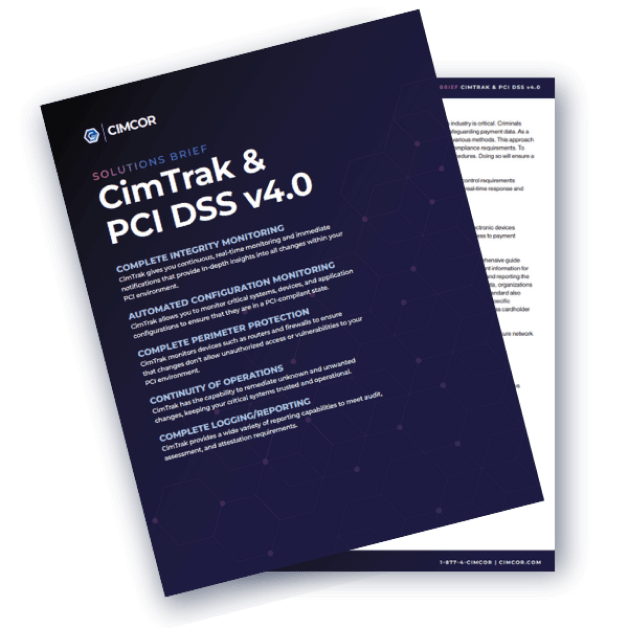Payment card data is the most commonly targeted information by cybercriminals. Keeping your customers' payment card information safe is a top priority as cyber threats become more sophisticated and advanced. That's where the Payment Card Industry Data Security Standard (PCI DSS) comes in, setting the security standard for businesses to abide by. As companies work to secure their operations and customer data, understanding PCI DSS is crucial.
Picture a world where every payment card purchase is shielded by an invisible but powerful layer of security. That's the essence of what PCI DSS compliance seeks to achieve. As complex as it sounds, it doesn't have to be impossibly difficult. In this article, let's break down the complexity of PCI DSS, focusing on common questions, main requirements, and how to achieve and maintain compliance in your infrastructure.
What is PCI Compliance?
PCI compliance is a set of requirements established by the PCI Security Standards Council (PCI SSC), an independent organization founded by major card brands, to address the growing threat of payment card data breaches and ensure cardholder data security. The PCI SSC provides recommendations, guides, and documents to help businesses and organizations become PCI-compliant.
PCI compliance is broken up into four levels, each based on the amount of transactions handled and processed by a business per year. PCI consists of twelve major operational and technical requirements split into six categories. These requirements cover various facets of network data protection and application security.
In March 2022, the PCI SSC released version 4.0 of PCI DSS, replacing the previous version, 3.2.1, and introduced several changes and improvements to strengthen data security efforts for businesses and organizations. Businesses have until March 31, 2024, to transition to the new requirements. For more information on these updates, see PCI DSS v4.0 At A Glance: The Vital Role of Integrity Management.
Who Needs to Comply with PCI DSS?
All businesses—no matter the size—that store, process, and/or transmit cardholder data must comply with PCI DSS requirements. While all businesses must comply, the level of compliance required is based on the number of payment transactions a business handles per year.
Consequences of Non-Compliance
While PCI isn't a legal requirement in the U.S., businesses can be subject to fines ranging from $5,000 to $100,000 a month for non-compliance. It is important to note that the PCI SSC will not penalize you for non-compliance. However, the Federal Trade Commission (FTC) monitors and penalizes organizations for non-compliance with PCI requirements. Businesses could also be subject to fines or penalties from their card providers if they do not adhere to PCI standards.
Fines and penalties aside, one of the most notable consequences of non-compliance is the loss of trust from your customers and stakeholders. In some cases, customers may reconsider doing business with an organization altogether due to the lack of security in protecting payment card data.
The 12 PCI DSS Requirements
The set of PCI requirements ranges from secure network configurations to rigorous access control that collectively forms a robust framework designed to mitigate risks associated with handling payment data. See A Beginner's Guide to PCI Compliance for a detailed breakdown of the following requirements.
| Category | Requirements |
| Build and Maintain a Secure Network and Systems |
1. Install and Maintain Network Security Controls 2. Apply Secure Configurations to All System Components |
| Protect Account Data |
3. Protect Stored Account Data 4. Protect Cardholder Data with Strong Cryptography During Transmission Over Open, Public Networks |
| Maintain a Vulnerability Management Program |
5. Protect All Systems and Networks from Malicious Software 6. Develop and Maintain Secure Systems and Software |
| Implement Strong Access Control Measures |
7. Restrict Access to System Components and Cardholder Data by Business Need to Know 8. Identify Users and Authenticate Access to System Components 9. Restrict Physical Access to Cardholder Data |
| Regularly Monitor and Test Networks |
10. Log and Monitor All Access to System Components and Cardholder Data 11. Test Security of Systems and Networks Regularly |
| Maintain an Information Security Policy |
12. Support Information Security with Organizational Policies and Programs |
Maintaining PCI Compliance - The Easy Way
As stated before, PCI compliance does not have to be difficult. Here are some tips to help you ensure you remain in line with PCI compliance and your data stays secure.
Tip #1: Continuous Monitoring
Utilizing advanced file integrity monitoring tools can help you stay on top of any unexpected changes within your systems. In fact, PCI DSS requires organizations to implement change detection mechanisms as defined in Requirements 10 and 11.
Tip #2: Routine Testing of Systems and Processes
Regular assessments are essential to identify vulnerabilities, weaknesses, and potential points of exploitation within your infrastructure. By conducting routine testing, businesses can proactively address any security gaps before it's too late. This process not only ensures ongoing compliance with PCI but also helps ensure the resiliency of your security posture.
Tip #3: Comprehensive Reporting
As you continuously monitor and assess your systems throughout the year, it is also essential to maintain detailed records of changes in your infrastructure. This additional task will not only help internally as a tool to monitor patterns over time but also keep you ahead of the game when it comes time to perform your PCI audit and assessments—your team and your auditors will thank you.
Tip #4: Ongoing Training and Security Awareness
According to Verizon's most recent Data Breach Investigations Report (DBIR), Social Engineering attacks are one of the top three tactics cybercriminals use to manipulate users, accounting for 17% of breaches in 2023. As 74% of all breaches include a human element—the odds aren't in favor of thinking employees are immune to such attacks.
There is no single tool that can reduce security risk and safeguard your customers' payment card data as much as providing your employees with the education necessary to identify and thwart social engineering attacks.
Fast Pass to PCI Compliance
CimTrak empowers organizations in their PCI compliance journey through complete integrity monitoring, automated configuration monitoring, and complete perimeter protection of routers and firewalls, all without disrupting critical systems from continuously running.
CimTrak detects and notifies you of suspicious changes and has the ability to instantaneously revert any unwanted changes. CimTrak's built-in, automatic reporting capabilities are essential as organizations prepare for their regular PCI compliance audit, taking it a step further and preparing reports the way an auditor prefers to see them.
Another bonus—CimTrak can even run checks to ensure your systems are continuously in line with PCI compliance.
For more information on how CimTrak can fit into your organization and help meet 50+ PCI v4.0 controls, download the solution brief below or speak to one of our security specialists.
Tags:
Compliance,
February 20, 2024




